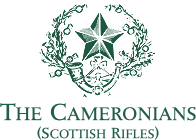 |
www.cameronians.org click here to print this page |
|
|
|
The Story of the Regiments - Richard Cameron
RICHARD CAMERON
One of the most noble of the Covenanters was a young man named Richard Cameron. Born in Falkland, Fifeshire, about the year 1648, he was the son of a prosperous merchant, and in due course went to college and took the usual degree. At first he may have had little sympathy with Covenanting principles. But he got into the way of attending the conventicles; and at last he stood forth, not only as a whole-hearted Presbyterian, but as a Covenanter of the sternest and most unbending type. He was too forceful a man to escape notice, and after a time he was persuaded to allow himself to be licensed as a preacher of the Gospel. Soon after he was on a visit to Holland, where many of the extreme Presbyterians were living as exiles; and while he was there great things happened in Scotland. The Covenanters took up arms.
At Drumclog, where The Covenanters met Claverhouse and his dragoons, they had a short-lived taste of victory. At Bothwell Brig, their cause sank in what seemed irretrievable defeat. But when Cameron came back from Holland in 1680 he struck a blow of amazing boldness. One day, about a year after Bothwell Brig, he rode into the market-place of Sanquhar in Dumfriesshire. With him were his brother Michael and a few other companions, all fully armed. After praise and prayer, a paper was produced, solemnly read aloud, and fixed to the Town Cross. After which, prayer was again offered, and then the little company rode away as quietly as they had come.
The paper was the famous Declaration of Sanquhar; and in it Cameron, on behalf of himself and all who might adhere to him, solemnly disowned Charles Stewart and declared war against him. Now, in the eye of the law, this was treason, and to many it must have seemed sheer madness. Anyhow, it sealed Cameron’s fate. A price of 5,000 merks was set upon his head. For about a month he evaded capture, but at last he and his friends were surprised by large forces at Airds Moss, in the parish of Auchinleck, Ayrshire. There was little time to be spared, but Cameron lifted up an impassioned prayer, in which he cried three times, “Lord, spare the green and take the ripe.” The Covenanters fought with magnificent bravery, but they were hopelessly outnumbered. Richard Cameron and his brother were amongst the slain. Richard’s head and hands were struck off and carried to Edinburgh, and it is said that the man who laid them before the Privy Council offered the simple but eloquent tribute, “There’s the head and hands that lived praying and preaching, and died praying and fighting.” It is said also that the sad relics were shown to Cameron’s father, who had been imprisoned in the Tolbooth for helping the field preachers at Falkland. The old man recognised them, and even amid the tears gave thanks to God.
To some modern eyes, Richard Cameron may seem a strange figure. Some people may think him little more than a hotheaded fanatic. But we must remember the darkness of the Covenanting times; the lamentable way in which the religious problem in Scotland was mishandled by those in authority; and the insensate folly with which loyal and God-fearing men and women were tormented and exasperated beyond endurance.
In many respects, Richard Cameron is a heroic figure. In his absolute fearlessness and outspokenness, in his scrupulous fidelity to what he conceived to be the will of God, in his determination to carry his principles to their logical issue - in all these things the man was truly great. And, withal, he had a tender heart. When he was denouncing the iniquities of the Government or the back-slidings of his countrymen, he spoke with a storm of invective; but when he was beseeching sinners to be reconciled to God, he poured out his soul in strains of affectionate and moving solicitude. And, as we shall see, what he did at Sanquhar was only what the nation itself did a few years after. He had been called “The Lion of the Covenant”; and the name is not ill-chosen.
Source: '300 Years of Service' published by the Regimental Trustees
www.cameronians.org